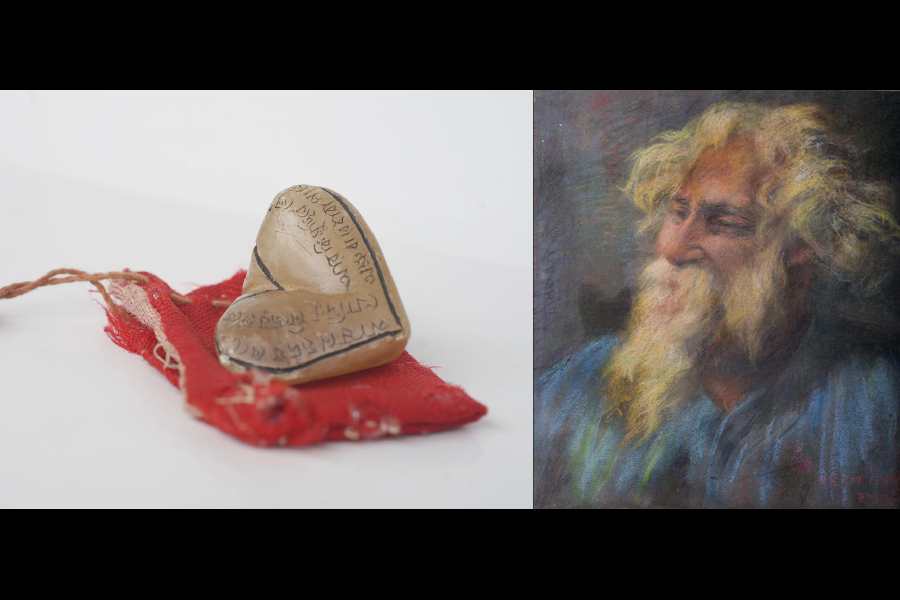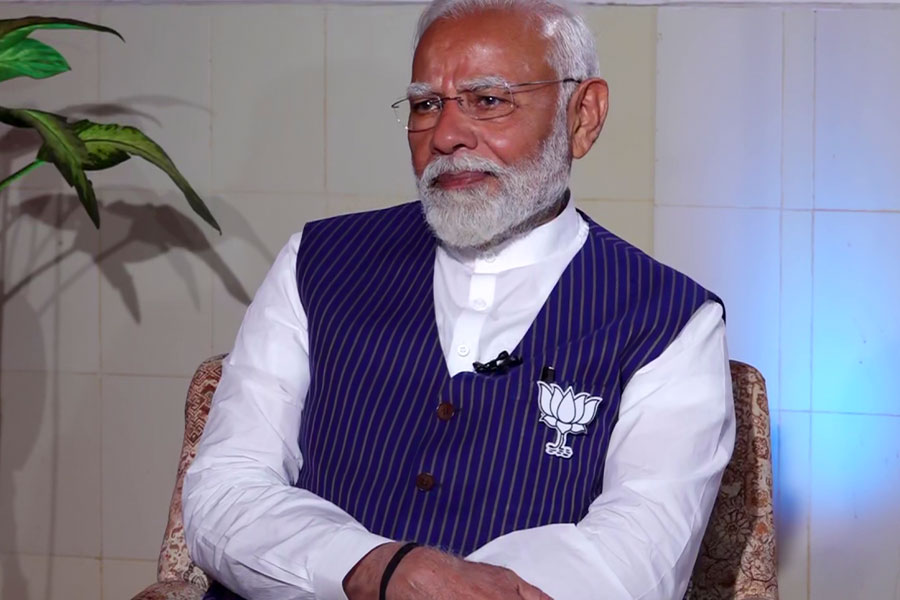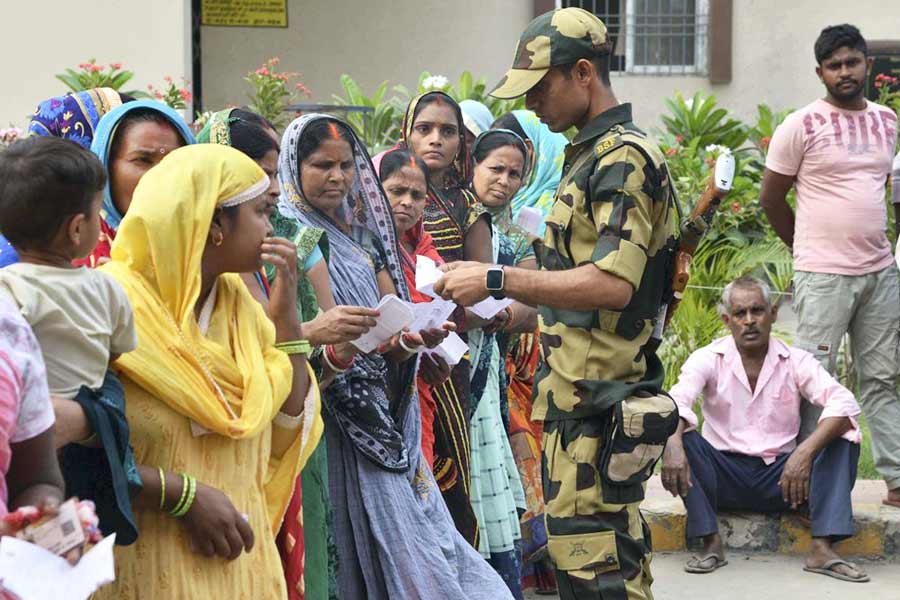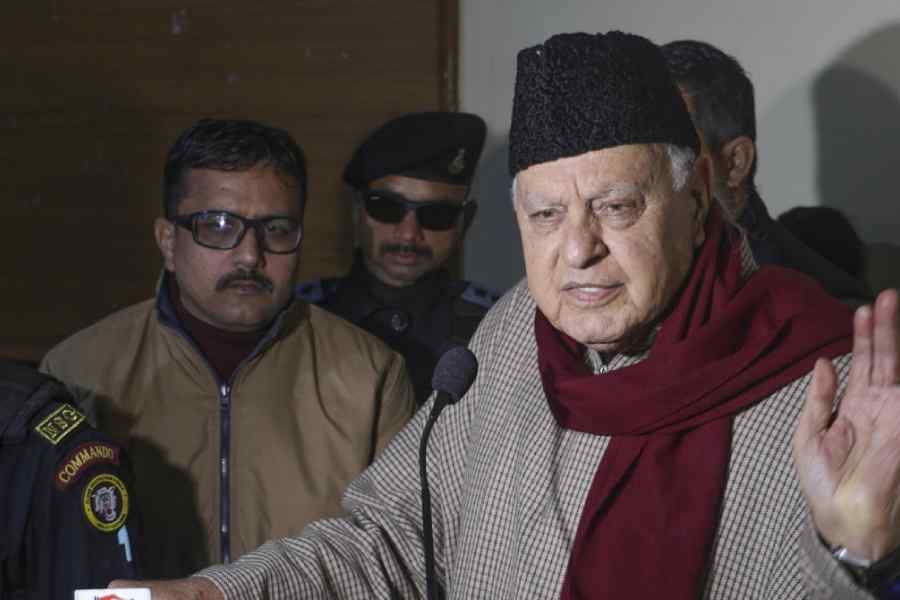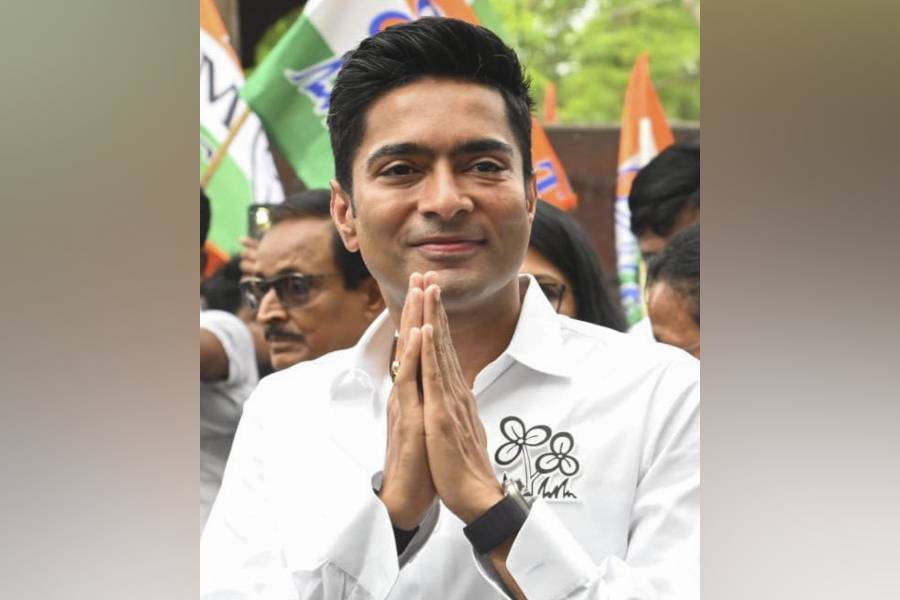Rabindranath Tagore (1861-1941) may have started painting late in his career, in his 60s, but he is never known to have taken up sculpture despite his enthusiasm for it. But now there is irrefutable evidence to the contrary.
In the first flush of his youth, Rabindranath had actually crafted out of a small piece of quartzite an object that is quite unmistakably the kind of heart symbol one associates with Valentine’s Day. Pouring his heart out, he inscribed on it a romantic couplet in Bengali that goes thus: “Pashan hriday kete/Khodinu nijer haate/Aar ki muchhibe lekha/Ashrubaridhara Paate”. Rabindranath’s “heart” was purportedly meant for his nameless beloved and it was kept in a tiny russet pouch with a drawstring.
The “heart” measures 4cmX4.5cmX3cm.
Both these never-seen-before objects will be exhibited at Debovasha at 70/2 Selimpur Road, Calcutta, for three days from May 25-27.
While it is known that the 22-year-old poet was in Karwar, a beautiful seaside city on the Kanara coast of Karnataka, in 1883, when he crafted the heart, the identity of his lady love remains a mystery. He was staying with his brother, Satyendranath Tagore (1842-1923), the first “native” to become a member of the coveted Indian Civil Service. He had been allotted Bombay Presidency Cadre.
They stayed in his large official bungalow made of Burma teak. Jyotirindranath Tagore (1849-1925), playwright, musician, editor, artist and translator, and his wife Kadambari Debi (1858-1884), were also there. She, being closer to the poet’s age, shared a warm relationship with him and he addressed her as “natun bouthan” or new sister-in-law. She was his muse as well and he valued her responses to his literary output. This has led to much speculation about the nature of their relationship, mostly of the lurid and sensational kind.
Later, they were joined by Satyendranath’s wife, Jnanadanandini Debi, and Swarnakumari Debi, Rabindranath’s elder sister.
Indira Debi Chaudhurani (1873-1960), who was the daughter of Satyendranath and Jnanadanandini and a litterateur in her own right, had referred to Rabindranath’s Karwar journey in her writing: “When Rabika was around 22, he stayed with us at Karwar port. He was summoned back home to get married while he was there.”
In the first volume of Prabhat Kumar Mukhopadhyay’s Rabindrajibani 1861-1901, the biographer wrote in a footnote: In 1883, while he was staying in Karwar, Satyendranath gave Rabindranath a lump of quartz. Rabindranath had carved it into the shape of a heart and presented it to Akshoychandra Choudhury. It is not known why he did so. To borrow Winston Churchill’s phrase: It’s a riddle wrapped in a mystery inside an enigma. Rabindranath had inscribed the afore-mentioned verse on the piece of quartz.
The only other document in which the heart of stone is mentioned is the Tagore Memorial Supplement of the Calcutta Municipal Gazette of September 13, 1941, edited by Amal Home, that is soon after the poet’s death. The issue carried a photograph of the heart of stone (exact size) and a translation of the poem in Bengali inscribed on it: “Having cut my heart of stone, I have engraved (the words) with my own hand. Will it (the writing) be ever effaced by the flow of tears?”
The caption of the heart of stone carried a curious note: Courtesy Mrs J.N. Bose, Reproduction strictly forbidden by the owner.
Akshoychandra Choudhury (1850-1898) MA BL, was a high court attorney and a luminary of Satyendranath’s literary salon. They were classmates and of almost the same age — hence 11 to 12 years senior to Rabindranath. He enjoyed Bengali literature as much as English, which he had learnt to appreciate under the supervision of an English professor at Presidency College. He had passed on to Rabindranath the intense excitement of reading English literature.
The other noted biographer of Rabindranath, Prashanta Pal, in his Rabijibani, had written that after meeting his father in Mussourie, Rabindranath returned to Calcutta mid-Ashwin (September-end and beginning of October) before setting forth for Karwar.
But Rabindranath and other family members returned to Jorasanko fromKarwar, and the peripatetic Debendranath wrote from Buxar on Agrahayan 22 (December 7, 1883) to the poet: “I am pleased that you have written to me after returning from Karwar.” From this it is understood that Rabindranath had returned a few days before his marriage on December 9, 1883.
Kamdambari Debi died by suicide four months after Rabindranath’s wedding on April 21, 1884. The Tagore family maintained a studied silence about her suicide. Rabindranath had dedicated some of his books of poems to her, and when he took up painting, her memory kept haunting him.
Like other members of his distinguished family, Rabindranath kept an open mind about Western culture. “Rabindranath first travelled to England in 1878, and before that, Annapurna or Ana Turkhud, had given him lessons in spoken English in Mumbai, where she lived with her progressive Marathi family. She was older than the poet and he had named her Nalini. She, too, was one of his creative influences,” says Sushobhan Adhikary, former curator, Kala Bhavana Museum, Visva-Bharati, who has worked extensively on Rabindranath’s paintings and the Santiniketan School of Art.
“Rabindranath’s visit to England was a turning point in his creative life. He had heard operas there and this acted as a stimulus. He composed Balmiki Pratibha and played the title role when it was staged at their Jorasanko home in 1881. There is photographic evidence. There is another photograph of Rabindranath composing the lyrics while Jyotirindranath set the words to music on the piano. There was an upsurge in his creativity, and before leaving for Karwar he had already written such verses as his lyrical Nirjharer Swapnabhanga at the Sudder Street home.”
In his Jiban Smriti, Rabindranath had written: “Through our deliberations of Indian and Western melody Balmiki Pratibha was born.” He recounted how Jyotirindranath would tirelessly experiment with Hindustani classical music on the piano. They were willing to build bridges.
Valentine’s Day, celebrated on February 14, was already a craze in Victorian England when Rabindranath visited the country. Lovers exchanged elaborate cards emblazoned with hearts, considered the seat of the soul, love and strength. It’s not impossible that the young poet had borrowed the idea and carved the heart of stone.
But how did the “heart” reach Debovasha? Rabindranath had given it to Akshoychandra Choudhury, whose wife was Sharat Kumari Debi. They left it to their daughter Uma Rani Basu, who, in turn, left it to her daughter Debjani Basu, who happened to be the wife of the celebrated artist Atul Bose. They had passed it on toIllora Basu, the wife of their elder son Abhijit. This lady has handed it to Debovasha, which held an exhibition of Atul Bose’s drawings in May 2022.
In August 2022, Debovasha also exhibited a portraitby Rabindranath that the poet had gifted Atul Bose. And now it is the turn of the heart of stone.

